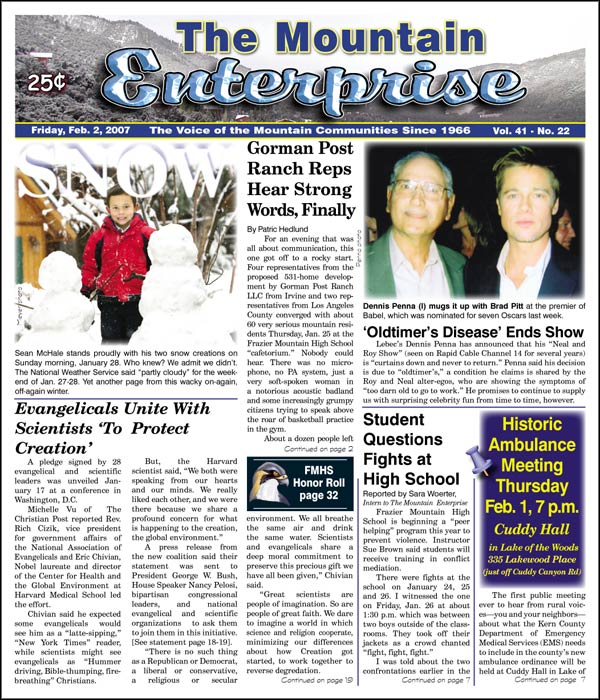Cuddy Hall
in Lake of the Woods 335 Lakewood Place (just off Cuddy Canyon Rd)
The first public meeting ever to hear from rural voices— you and your neighbors— about what the Kern County Department of Emergency Medical Services (EMS) needs to include in the county’s new ambulance ordinance will be held at Cuddy Hall in Lake of the Woods, Thursday, Feb. 1, at 7 p.m.
This is a historic meeting, secured because residents of these Mountain Communities travelled to Bakersfield on December 5, 2006 to explain to the Kern County Board of Supervisors why rural communities need a chance to help to improve the ordinance before it is adopted in June 2007.
EMS Director Ross Elliott will be here Thursday to explain the Draft Ordinance for Ground Ambulance Service. “I will pass out [a] handout showing the comparison of the old and new [ambulance standards],” Elliott said Monday, then he will open the floor for public comments. In an email note he added, “somehow, I doubt that there will be a shortage of issues to discuss!”
UCLA statistician and Cuddy Valley resident Jan de Leeuw has pointed out a number of issues that rural families may wish to address in the draft rules. His comments are compiled online at www.MountainEnterprise.com (in the left column under “Community FYI,” click “Ambulance”).
He pointed out that rural families may be at risk under the draft ordinance, in part because of the “100 call rule” which assesses the performance of the ambulance service based on the percentage of on-time responses over 100 calls.
Supervisor Jon McQuiston, who represents rural regions of the Kern River Valley, pointed out at the December 5 meeting that in a “low call volume” region, such as the residential zones of our Mountain Communities, it could take an excessive time to even attain 100 calls, leaving an ambulance company potentially without consequences for over two years, even if their service performance was substandard. Elliott will explain how he feels rural areas are protected from that scenario.
How records of calls and complaints are maintained, who maintains them, and how long records should be saved are other items that those familiar with national standards say should be reviewed. Retaining call records for three years helps to develop a picture of a company’s service and to maintain legal accountability researchers say. This early ordinance allows records to be destroyed after six to twelve months.
This meeting is the first of seven rural workshops, including Delano, Shafter/Wasco, Mojave, Lake Isabella, Taft and Ridgecrest.
This is part of the February 02, 2007 online edition of The Mountain Enterprise.
Have an opinion on this matter? We'd like to hear from you.


